All published articles of this journal are available on ScienceDirect.
High Speed Rail Passenger Profile in Sun and Beach Tourism Destinations: The Case of Alicante (Spain)
Abstract
This paper aims to study and highlight the profile of the high speed rail (HSR) passenger in the case of the well-known sun and beach destination of Alicante, located in the Southeast of Spain. This region, which is directly connected with Madrid, differs from others because of its warm and sunny weather. The province is a tourist destination for both Spanish citizens and foreigners. However, the studies on the dynamics of the corridor towards Madrid and Alicante regarding HSR are quite recent and it is not possible to draw final conclusions about its impact on tourist mobility.
INTRODUCTION
Alicante province has around 250 kilometres of Mediterranean coast with a warm climate that attracts tourism from the rest of Spain, mainly Madrid and surroundings and also the North of Spain. Besides, sun and beach tourism and related business, which are part of the Alicante culture and showcase, gives the region a large experience in tourism. Apart from Alicante city, Benidorm (73,768 inhabitants [1] and triplicates with tourists) and Torrevieja (105,205 inhabitants [1] and duplicates with tourists) are both famous sun and beach touristic cities located in this region. Furthermore, the Comunidad Valenciana is on the TOP 5 of total touristic spending in Spain [1] and tourism represents the 12,6% of GDP and 13,4% of employment [2].
In June 2013 Alicante (335,052 inhabitants [1]) started to be connected with Madrid (3,207,247 inhabitants [1]) through HSR (Fig. 1). Nowadays, there are direct train services between these two cities and others that stop at Cuenca (56,107 inhabitants [1]), Albacete (172,693 inhabitants [1]) and Villena (34,834 inhabitants [1]). Some demand studies of this corridor expect this line to be one of the most crowded in Spain. Initially, the estimated time for this 500 km trip was 2 hours and 30 minutes but after the first operational year is around 2 hours. Before the implementation of HSR, the conventional rail used to take 3 hours and 10 minutes from Alicante to Madrid. Therefore, now the timesaving is more than 1 hour.
Studies regarding the relation between HSR and sun and beach tourism cannot be found because this is a specific type of tourism, particularly in Spain. Thus, results from a new survey have been evaluated and a summary of them can be found in this paper. In addition, a brief review of the relationship between tourism and HSR is exposed in the next section.
MATERIALS
As mentioned above, references to sun and beach are limited because only Madrid-Malaga corridor, in service since 2007, can be similar to Madrid-Levante corridor. The peak flows of passengers in Madrid-Málaga corridor are characteristic on Fridays (destination Malaga) and Sundays (destination Madrid), which is clearly associated to touristic activity at Costa del Sol. At European level, the other corridor where tourism is the main reason for travelling is the Mediterranean TGV (Paris-Marseille) in service since 2001.
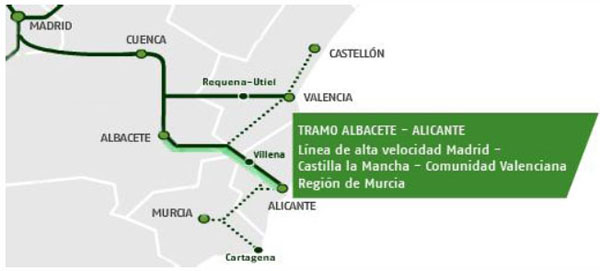
High speed rail line madrid-levante. Source: [3].
Moreover, the most relevant conclusions of related studies carried out in French and Spanish non touristic corridors are:
- As the new transport mode implies travelling, the influence of HSR on tourism is almost immediate whereas territorial impacts usually take at least six years to be shown [4].
- It seems to be confirmed that HSR tourist profile is an urban one. Moreover, in touristic cities are necessary complementary activities such as leisure and business reason for travel [5].
- Usually, in cities with HSR stations, there are a generation effect of renown, trendiness and innovation. For that, and not only on HSR services arrival, the strategies from local and regional agencies are a key driver. Moreover, touristic promotion needs to be taken for a long time [6]. In this way, hotels on medium cities with HSR services have improved the products (business, executive and modern design rooms and suites), higher and better hotel status, etc. [7].
- In the case of TGV to Marseille (Mediterranean TGV) influence in tourism it is shown as changes in the tourist profile. For example, short time travels and young, retired, executive and international passenger profiles have increased [8]. Furthermore, the number of passengers increased from 3 to 5 million and also the modal distribution grew from 14% in 1997 to 21% in 2003 (mainly transferred from car and plane) [6].
Focusing on sun and beach tourism and their particularities, looking for data about travelling reason, accommodation type, mode of transport, group composition etc., and some results of the Touristic Studies Institute for Comunidad Valenciana [9] are:
- Regarding accommodation, public transport service is relevant for hotel (32%) and rented house (35%) whereas the use of car is exclusive for ownership (98.1%) and familiar houses (88.7%). These results show that compact cities (where there is an important amount of hotels) encourage the use of public transport services much more than those with a urban sprawl model.
- In relation to group composition, mode of transport and accommodation election, public transport is relevant for one person (26%) and two people (20%). In addition, the smaller group, the more important the hotel accommodation election is (3 people, 11.6%; 2 people 17.6%; 1 person 29.7%).
- Regarding tourist age and mode of transport, bus and train are the most popular (31% and 26%) for younger and retired people respectively. Consequently, the car is very important for the rest of ages (88%).
- With respect to the length of the stays, hotels (50.2%) and rented houses (78.7%) use to be 4 nights or more. For hotels, short and long accommodations are balanced.
- Finally, regarding the origin of tourist, the farther they come, the more significant the hotel accommodation is. Thus, only the 7.9% of tourists from Comunidad Valenciana choose hotels whereas in the case of Madrid and País Vasco, 23% and 48% respectively choose hotels.
To sum up and as a main result, touristic cities with hotel accommodation specialization show more potentials to take advantage of the opportunities that bring the HSR services than cities based on second homes.
Methodology
In order to analyse the passenger’s profile and mobility patterns, the first step is to determine the sample size to achieve a 95% confidence level (margin of error 5%). Demand studies expect approximately 1,800,000 passengers per year [10], hence, to cover all passengers’ profile 1,540 surveys should be picked up. Definitively, 1,963 respondents in the new high speed station in Alicante were registered. The survey has been distributed throughout the four seasons of the year (autumn, winter, spring and summer) so as to measure the differences in passengers’ profiles at different times of the year (Fig. 2). In the next level, the surveys also differentiate between weekdays (Tuesdays and Thursdays) and weekends (Saturdays and Sundays). During a survey day, all long distance trains are covered in order to catch every profile.
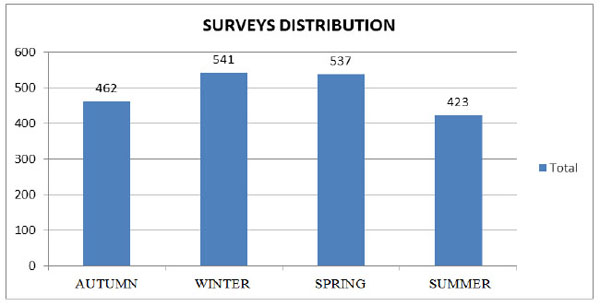
Distribution of surveys in 2014. Source: own research.
Furthermore, it should be noted that all surveys have taken place in Alicante Station to passengers waiting for the train, both who go back to Madrid or other locations after holidays, business in Alicante province, and passengers from Alicante province whose destination was inland Spain. Although the survey is focused on sun and beach tourism, it also gives information about business passengers and other types (cultural, familiar, sports, etc.).
Finally, the structure of the survey includes questions that will show information about modal transference, origins and tourist destinations, type of tourism (sun and beach, urban, cultural, etc.), accommodation demand (hotel, second home or similar), access time to the train station, mode of transport in origin and destination, etc.
RESULTS
As discussed above, first results have been summarized and this paper shows some of them that have been evaluated.
First of all, the survey shows which destination, Madrid or Alicante, is the most important in the corridor. With respect to Madrid, capital of Spain, this takes passengers from Alicante because of the attraction of the administrative services and global business. Regarding Alicante, it is expected to take passengers from inland regions for touristic reasons. In other words, the question is whether HSR, in this case, favours the centrality of the big city (Madrid) rather than the small one (Alicante and its province); it is the so-called suction. Although it is needed more precise total travellers data during each season, the results for the effect [11] is question are that 49% of passengers of the corridor travel from Madrid to Alicante and around 29.6% from Alicante to Madrid (the rest of passengers are people coming or going to other cities). Even in winter, the row season for sun and beach tourism, there are more travellers from Madrid to Alicante (11.2% of winter passengers) than vice-versa (9.3% of winter passengers), which lets to advance that, instead of the suction effect, benefits for both urban agglomerations it is detected due to the main activities developing at each cities are complementary rather than similar.
Moreover, the reason for travel according to the destination is important. The usual reasons in HSR are expected to be business (being the most important one) as well as cultural and urban tourism. In the case of Madrid destination the reasons are clear because the city has these resources (it also appears sun and beach reason because of the international airport with paradisiacal destinations) (Fig. 3). However, in the case of Alicante it is not so clear because of the passengers’ flow is balanced. The results show what the main reasons for travelling to Alicante are: for around 50% of passengers, sun and beach are the main reason for travel, whereas for a 25% of passengers are equally distributed between family trip and business as main reasons (Fig. 4).

Travelling reason for Madrid destination. Source: own research.
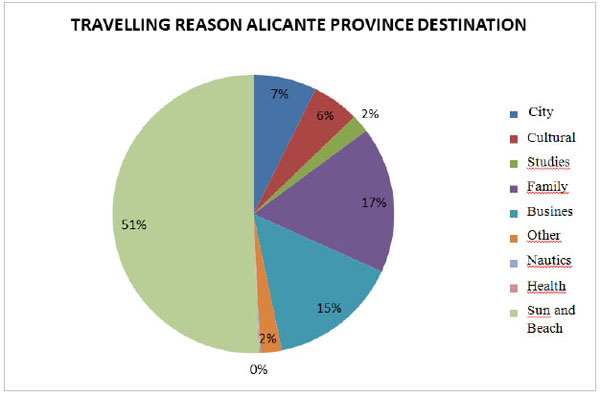
Travelling reason for Alicante province destination.Source: own research.
Other significant result shows that destinations on the coast change depending on the season of the year. Besides, the passenger profile is different depending on the train schedule. In that last point, HSR is used, nowadays, as an airlift between Alicante and Madrid. It is known because of the number business passengers with destination Madrid has increased while there are higher cancellations of flights from Alicante-Elche Airport to Madrid-Barajas Airport.
Distinguishing among seasons, in winter, Madrid is the main destination followed by some sun and beach ones but, as mentioned above, Alicante province is most important than Madrid as a destination. Therefore, when summer comes, coastal destinations become more popular although Madrid continues to be present (Figs. 5 and 6).
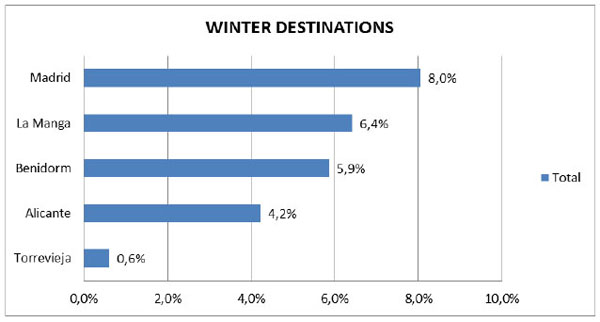
Destinations in winter.Source: own research.
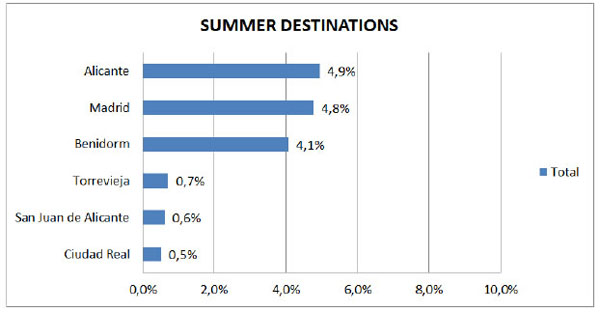
Destinations in summer.Source: own research.
Focusing on sun and beach origins and destinations, it is observed that there are multiple origins for a few destinations. In the case of origins, the central region of Spain, with other cities around Madrid, and some cities from the north are the most relevant (Fig. 7).

Sun and beach origins.Source: own research.
In the case of specific sun and beach destinations, Benidorm is the main city followed by La Manga and Alicante, covering the 30% of all the destinations (Fig. 8). It is remarkable that the higher percentage reached in Benidorm with respect to Torrevieja could be explained by the different tourist models between them. Benidorm is characterised by hotels and urban compactness (Fig. 9) whereas Torrevieja is more residential and urban sprawl model. Thus, the synergies between the compactness and public transport (HSR) are evident unlike the sprawl model, which is car-oriented (Fig. 10).
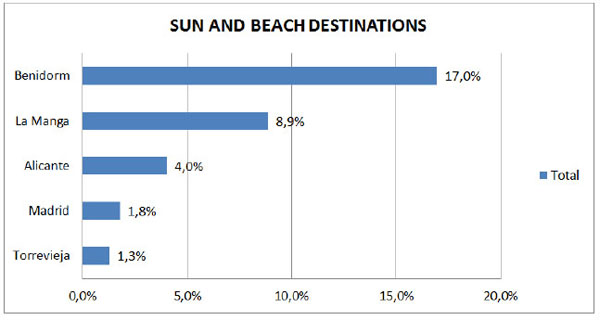
Sun and beach destinations.Source: own research.
As for the access to Alicante station, the relation between the number of passengers per thousand inhabitants and time accessibility has been evaluated through surveys (Fig. 11). The results are consistent with the theory (the number of passengers are relatively decreasing with time) although there are some exceptions like Elche (a big city with 228.647 inhabitants) and some towns connected through tramway (Fig. 11). In the case of Elche, the results may show how other factors may affect the use of the HST services, such as the size of population, which implies that there are a larger number of residents working on tertiary activities than in smaller cities or villages.

Benidorm city. Source: Google images.
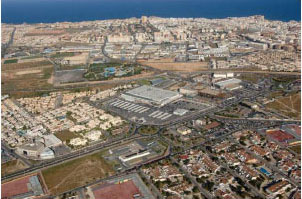
Torrevieja city. Source: Google images.
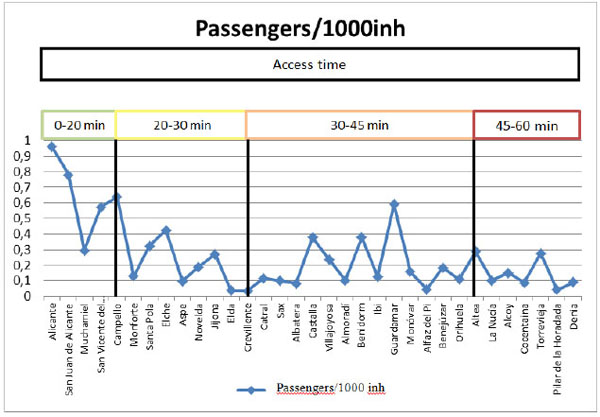
Alicante station origins per distance time. Source: own research.
In relationship between the passenger’s reason for travel and their academic level, it is noticed that passengers travelling for business reasons mainly have university level. Meanwhile, passengers travelling for sun and beach reasons do not present a steady pattern. This last outcome shows that for the different seasons the educational level for passengers travelling for sun and beach reasons change.
In terms of accommodation, first results show that HSR passengers often chose accommodation at hotels but sun and beach passengers also stay at second houses in summer and autumn (even though the hotel is mainly used). The majority of passengers use hotels between three and four stars.
Nevertheless, there is a difference in accommodation between business and sun and beach profiles. This difference is the number of nights spent in destination. While business passenger usually stay for one or two nights, sun and beach passengers tend to stay for more than seven nights, most of them for even more than nine.
Once having studied the characteristics of passengers’ profile, let us see the characteristics of transport itself. The previous transport modes for passengers of the corridor were other trains (64%), car (18%) and then, plane (10%) and bus (6%). This data show transference from car and plane but, whereas the car is a real transference, the plane is partially forced. It is forced because, in anticipation of the possible transference, some particular airlines have cancelled some services between Alicante and Madrid (especially early hours that are demanded by business passengers). In the case of transference from other trains, they mainly come from the previous long distance services. Finally, the bus shows a low transference because it still has a very low cost in opposition to HSR, although with the liberalization it is expected lowest prices for HRS, especially for tourists which are more sensitive to fares than business as shown later.
As for induction effect, near 80% of interviewed passengers travelling to Alicante answered that HSR services were decisive. Among those travelling to Madrid the percentage is around 50%. But, asking if they would come even without HSR, 85% of the passengers travelling to Alicante answered that they would. In the case of Madrid, the number of positive answers was 74%. So, from an analytic point of view, for 15% HSR interviewed passengers the key to travel to Alicante and for a 26% in the case of Madrid was the HSR. To sum up, Madrid would have generated a 26% of inducted trips and Alicante a 15%. The results are consistent due to the attractiveness of Madrid is higher than Alicante for the first HSR operational years to visit the city, museums, etc. In the case of Alicante, where tourism for sun and beach can be more routine and steady for medium or long periods during holidays, inducted trips are lower, though the tourists can increase the frequency to visit Alicante. Just the number of trips inducted in Alicante, the long stays for tourists and the high expenses per stay, especially for those who choose hotels, such as in Benidorm, reinforces the initial possibility of benefits from Alicante rather than suction from Madrid as a full HSR impact. As the survey has been carried out during the first year of service, the induction in favour to Madrid is stronger as it seems to be a more attractive city than Alicante. Therefore, the induction towards Madrid might decrease over the years whereas towards Alicante it is expected to be almost steady.
With regards to access transport mode, in the case of Madrid (big city) the main modes are bus and taxi (10% each) followed by car, on foot and urban trains as equal. On the other hand, in the case of Alicante (medium city), the main access transport modes are car (11%) and taxi (8.5%), followed by family’s car and public transport such as bus and tramway (between 5% and 4%).

Access time per transport mode at Madrid train station. Source: own research.
Disaggregating data about modal share of rail station accessibility and focusing on access time, it is interesting to observe what happens at Madrid and Alicante train stations. In Madrid Station, people takes five minutes to get the station mainly come on foot, whereas who takes ten minutes use cars and taxis. Taxis are still used by those taking up to twenty minutes to arrive to the station. For lengths of more than twenty minutes, public transport (buses, underground and urban train) is the most common mode of transport (Fig. 12). In the case of Alicante, as the modal share of rail station accessibility is different from Madrid, the time distribution is also different. People taking five minutes to get the station mainly come on foot, taxi and public transport. Those taking between ten and twenty minutes prefer taxis and cars as the main transport modes. For those taking more than twenty minutes, cars and public transport are the chosen modes (Fig. 13). Therefore, in Madrid public transport is more used than in Alicante for all time lengths, whereas in Alicante the car is more frequently used than in Madrid.
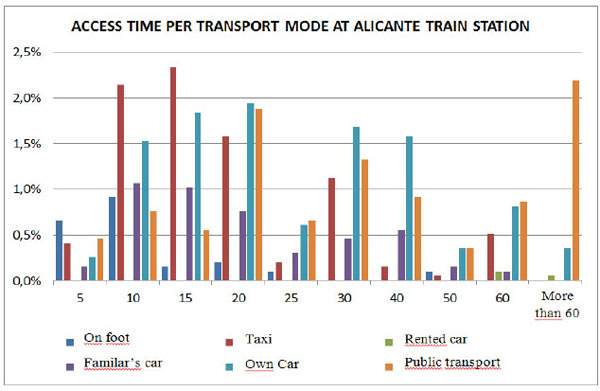
Access time per transport mode at Alicante train station. Source: own research.
CONCLUSION
To conclude, after the first HSR operational year between Madrid and Alicante, the flow of travellers towards Alicante province is higher than vice-versa. According to this line, the so-called suction effect between the big city and the medium one is not that clear, as both cities benefit from each other; Alicante needs business from Madrid and passengers from Madrid to travel for sun and beach tourism reasons.
In this way, the HSR passengers tend to choose hotel accommodation but, in the case of sun and beach trip reasons, where hotel is the main accommodation, second houses are relevant too. As a result of this, sun and beach places with low urban density usually receive fewer travellers than the ones with high urban density (such as the cases of Torrevieja with respect to Benidorm).
Focusing on accommodation, sun and beach travellers usually stay for long periods, whereas business ones stay for shorter periods.
In terms of transport, modal transference comes mainly from cars (highways) and previous or other rail services. Furthermore, in the short future scenario a liberalization of HSR services will take place in Madrid-Alicante corridor. This event, and its effect on a possible decrease in fares apart from others, might increase the demand of HSR services for sun and beach reasons towards Alicante province. In terms of inducted trips, a 15%-26% of passengers of the corridor are new and the big city shows more passengers inducted.
Particularly, the passengers liberalization expected for 2015 plays a role to improve the services and attract passengers for tourism but, what kind of tourism and which strategies? As an overall data, only 20% of the total trips on the Corridor Madrid-Levante (where Alicante is included) are by train, whereas 60% by car (Ministry of Public Works press release). So, how to grab passengers from cars, classical familiar and residential tourism? Only through the fares, for example, is it possible to include a familiar car into a train to improve tourist´s willingness to travel by train towards Alicante? That was possible from 1960s to 2000s. However, with the arrival of the HSR -technical reasons do not allow to join coaches for cars to high speed trains and increase of services-, the Autoexpreso Service disappeared. Nowadays, this service is offered at the Channel Tunnel between Great Britain and France [12] and, much more similar to Madrid-Alicante, the SNCF offers the service (Auto/train) between Paris and most of the cities in the South of France [13].
CONFLICT OF INTEREST
The authors confirm that this article content has no conflict of interest.
ACKNOWLEDGEMENTS
Declared none.


